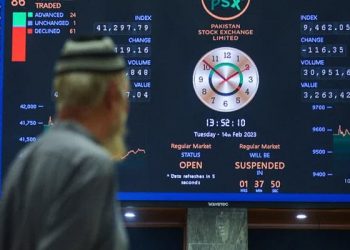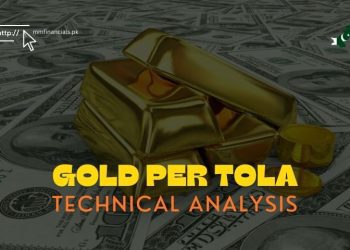In a notable uptick, the per tola price of 24 karat gold surged by Rs 2,500 on Monday, reaching Rs. 240,500 compared to its previous sale at Rs. 238,000 on the last trading day. This significant increase was mirrored in the price of 10 grams of 24 karat gold, which rose by Rs 1,257 to Rs 206,190 from Rs 204,047. Similarly, the prices of 10 grams of 22 karat gold also experienced an upward trend, climbing to Rs 189,007 from Rs 187,043, as reported by the All Sindh Sarafa Jewellers Association.
Despite these notable shifts, the price of silver remained stable, with the per tola and ten gram prices holding steady at Rs 2,620 and Rs 2,254.80 respectively.
This surge in local gold prices follows a global trend, with the price of gold in the international market witnessing a $21 increase, rising to $2,322 from $2,301, according to the Association’s data.
Market analysts suggest that various factors, including geopolitical tensions and inflationary concerns, have contributed to the recent bullish trend in gold prices both locally and internationally. Investors are closely monitoring these developments, which may continue to impact gold prices in the coming days.
GOLD PRICES SURGE AMIDST US JOBS DATA AND CHINESE ECONOMIC SIGNALS
Gold prices experienced a notable rebound on Monday, driven by a confluence of factors including recent US employment data and Chinese economic indicators. The market sentiment, influenced by the outlook for interest rates, played a pivotal role in the surge of gold prices.
Friday’s release of the US Nonfarm Payrolls data by the Bureau of Labor Statistics revealed that only 175,000 individuals found employment in April, falling below market expectations. Of particular note was the slowdown in wage inflation, with Average Hourly Earnings failing to meet economist forecasts both annually and monthly. This unexpected data has sparked speculation that the Federal Reserve (Fed) might consider lowering interest rates sooner than previously anticipated. Lower interest rates tend to enhance the appeal of gold as they diminish the opportunity cost of holding the non-yielding asset.
In addition to the US economic indicators, attention was also drawn to Chinese economic data. The release of the Chinese Caixin Services PMI for April indicated that the services sector continued to expand, remaining above the crucial threshold of 50. Despite recent economic challenges faced by China, this data fosters optimism regarding the demand for gold in the country. The resilience of the Chinese economy and the sustained expansion in its services sector suggest ongoing support for gold demand, further bolstering its attractiveness to investors.
In light of these developments, market analysts anticipate continued volatility in gold prices as investors closely monitor economic indicators and central bank policies for further cues on the precious metal’s trajectory.
CENTRAL BANK GOLD ACQUISITIONS MAINTAIN POSITIVE MOMENTUM
Central banks worldwide continue to exhibit a steadfast interest in gold, as evidenced by recent data from the World Gold Council (WGC) indicating a net acquisition of 15 tonnes in March. This trend underscores the ongoing significance of central banks as key players in the gold market, a role they have increasingly embraced in recent years.
The latest figures from the WGC align with previous months, affirming the sustained positive trajectory in central bank demand for gold. Krishan Gopaul, Senior Analyst at the WGC for the Europe, Middle East, and Africa (EMEA) region, highlighted the continuation of buying strength throughout 2024. Notably, emerging market banks have emerged as pivotal drivers behind both purchases and sales within the gold market.
The resilience of central bank acquisitions reflects the enduring appeal of gold as a strategic asset for diversification and wealth preservation. Amidst economic uncertainties and evolving geopolitical dynamics, central banks are leveraging gold to bolster their reserves and hedge against various risks.
As central banks continue to assert their presence in the gold market, analysts anticipate sustained demand for the precious metal, with emerging markets playing a pivotal role in shaping future trends. This steadfast interest underscores the enduring allure of gold as a timeless store of value in an ever-changing global landscape.
TECHNICAL ANALYSIS: GOLD PRICE ENTERS CONSOLIDATION PHASE
On the 4-hour chart, the gold price (XAU/USD) has transitioned into a sideways trading pattern, indicative of a consolidation phase in the short-term trend.
Recent price action has seen the pair testing the upper boundary of a mini-range around $2,326, coinciding with the 50 Simple Moving Average (SMA) depicted in red on the chart. However, a retreat from this level suggests potential downside momentum.
In the event of further retracement, the price may decline towards the lower boundary of the range near $2,280. Conversely, a breakout above the range’s upper limit could propel the price towards resistance at $2,353, which corresponds to the late April swing high and the peak of wave B.
A decisive breach above the range’s upper boundary would signal a bullish continuation, potentially targeting a conservative objective at $2,353, representing the top of wave B and the 0.681 Fibonacci extension calculated from the range’s height. In an optimistic scenario, the price could even aim for $2,370.
Confirmation of a breakout would be marked by notable price action, such as an extended green candlestick piercing above the range ceiling and closing near its high, or a sequence of three consecutive green candlesticks surpassing the respective level.
Traders are advised to closely monitor price developments within this range-bound environment, as a breakout could offer lucrative trading opportunities aligned with prevailing market sentiment and technical signals.
GOLD PRICE ANALYSIS: POTENTIAL UNFINISHED MEASURED MOVE PATTERN
Recent price action in gold suggests the emergence of a bearish Measured Move pattern, initiated on April 19th. This pattern typically comprises three waves denoted as A, B, and C, with wave C often equaling wave A or a Fibonacci extension of it. Currently, the price has descended to the conservative target for wave C, estimated at $2,286, representing the Fibonacci 0.681 extension of wave A.
However, there’s a possibility that wave C could extend further downwards, potentially reaching the 100% extrapolation of wave A at $2,245. Confirmation of such a move would require a decisive break below the established range and the low of May 3rd at $2,277.
It’s crucial to note the broader trend in gold prices, which remains upward on both medium and long-term charts (daily and weekly). This overarching trend lends support to the bearish outlook observed on lower time frames.
Traders should exercise caution and closely monitor price movements for potential confirmation of the continuation of the bearish Measured Move pattern. A breach of key support levels could indicate further downside potential, while adherence to the prevailing upward trend in the medium and long term may provide context for trading decisions.



















